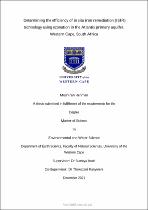| dc.contributor.advisor | Israel, Sumaya | |
| dc.contributor.author | Rehman, Mushirah | |
| dc.date.accessioned | 2022-08-10T12:52:38Z | |
| dc.date.available | 2022-08-10T12:52:38Z | |
| dc.date.issued | 2022 | |
| dc.identifier.uri | http://hdl.handle.net/11394/9228 | |
| dc.description | >Magister Scientiae - MSc | en_US |
| dc.description.abstract | In situ iron remediation (ISIR) applications has become a popular technique for reducing iron
and manganese concentrations in boreholes that impose aesthetic and potable issues to
groundwater quality and water supply schemes. Production borehole yields are reduced by
screens clogged with iron and manganese precipitates, which jeopardizes groundwater
extraction volumes and affect the supply of groundwater from supply schemes. Repeated ironand
manganese-related borehole clogging in primary and fractured rock aquifers is a wellknown
phenomenon in South Africa’s potable groundwater supply schemes. | en_US |
| dc.language.iso | en | en_US |
| dc.publisher | University of the Western Cape | en_US |
| dc.subject | Ozonation | en_US |
| dc.subject | Water quality | en_US |
| dc.subject | Groundwater | en_US |
| dc.subject | In situ iron remediation (ISIR) | en_US |
| dc.subject | Atlantis primary aquifer | en_US |
| dc.subject | Western Cape | en_US |
| dc.title | Determining the efficiency of in situ iron remediation (ISIR) technology using ozonation in the Atlantis primary aquifer, Western Cape, South Africa | en_US |
| dc.rights.holder | University of the Western Cape | en_US |

